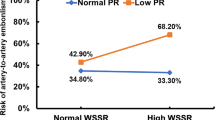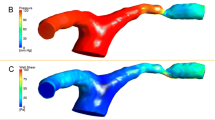Abstract
Objectives
To evaluate the relationship between hemodynamics and vessel wall remodeling patterns in middle cerebral artery (MCA) stenosis based on high-resolution magnetic resonance imaging and computational fluid dynamics (CFD).
Methods
Forty consecutive patients with recent ischemic stroke or transient ischemic attack attributed to unilateral atherosclerotic MCA stenosis (50–99%) were prospectively recruited. All patients underwent a cross-sectional scan of the stenotic MCA vessel wall. The parameters of the vessel wall, the number of patients with acute infarction, translesional wall shear stress ratio (WSSR), wall shear stress in stenosis (WSSs), and translesional pressure ratio were obtained. The patients were divided into positive remodeling (PR) and negative remodeling (NR) groups. The differences in vessel wall parameters and hemodynamics were compared. Correlations between the parameters of the vessel wall and hemodynamics were calculated.
Results
Of the 40 patients, 16 had PR, 19 had NR, and the other 5 displayed non-remodeling. The PR group had a smaller lumen area (p = 0.004), larger plaque area (p < 0.001), normal wall index (p = 0.004), and higher WSSR (p = 0.004) and WSSs (p = 0.023) at the most narrowed site. The PR group had more enhanced plaques (12 vs 6, p = 0.03). The number of patients with acute stroke in the PR group was more than that in the NR group (11 vs 4, p = 0.01). The remodeling index (r = 0.376, p = 0.026) and plaque area (r = 0.407, p = 0.015) showed a positive correlation with WSSR, respectively.
Conclusions
Hemodynamics plays a role in atherosclerotic plaques and vessel wall remodeling. Individuals with greater hemodynamic values might be more prone to stroke.
Key Points
• Stenotic plaques in middle cerebral artery with positive remodeling have smaller lumen area and larger resp. higher plaque area, normal wall index, translesional wall shear stress ratio, and wall shear stress than negative remodeling.
• The remodeling index and plaque area are positively correlated with translesional wall shear stress ratio.
• Hemodynamic may help to understand the role of positive remodeling in the development of acute stroke.



Similar content being viewed by others
Abbreviations
- CFD:
-
Computational fluid dynamics
- CTA:
-
Computed tomography angiography
- DWI:
-
Diffusion-weighted imaging
- FLAIR:
-
Fluid-attenuated inversion recovery
- HRMRI:
-
High-resolution magnetic resonance imaging
- ICAD:
-
Intracranial atherosclerotic disease
- ICC:
-
Intraclass correlation coefficients
- LA:
-
Lumen area
- MCA:
-
Middle cerebral artery
- MIP:
-
Maximum intensity projection
- MRA:
-
Magnetic resonance angiography
- NR:
-
Negative remodeling
- NWI:
-
Normal wall index
- PA:
-
Plaque area
- PDWI:
-
Proton density–weighted imaging
- PR:
-
Positive remodeling
- RP:
-
Translesional pressure ratio
- WSSR:
-
Translesional wall shear stress ratio
- WSSs:
-
Wall shear stress in stenosis
References
Zhang DF, Chen YC, Chen H et al (2017) A high-resolution MRI study of relationship between remodeling patterns and ischemic stroke in patients with atherosclerotic middle cerebral artery stenosis. Front Aging Neurosci 9:140
Wang Y, Zhao X, Liu L et al (2014) Prevalence and outcomes of symptomatic intracranial large artery stenoses and occlusions in China: the Chinese Intracranial Atherosclerosis (CICAS) Study. Stroke 45:663–669
Arenillas JF (2011) Intracranial atherosclerosis: current concepts. Stroke 42:16
Li D, Dai W, Cai Y et al (2018) Atherosclerosis in stroke-related vascular beds and stroke risk: a 3-D MR vessel wall imaging study. Ann Clin Transl Neurol 5:1599–1610
Wu F, Zhang Q, Dong K et al (2019) Whole-brain magnetic resonance imaging of plaque burden and lenticulostriate arteries in patients with different types of stroke. Ther Adv Neurol Disord 12:1756286419833295
Wu F, Song H, Ma Q et al (2018) Hyperintense plaque on intracranial vessel wall magnetic resonance imaging as a predictor of artery-to-artery embolic infarction. Stroke 49:905–911
Ryu CW, Jahng GH, Shin HS (2014) Gadolinium enhancement of atherosclerotic plaque in the middle cerebral artery: relation to symptoms and degree of stenosis. AJNR Am J Neuroradiol 35:2306–2310
Wang E, Shao S, Li S et al (2019) High-resolution MRI study of the relationship between plaque enhancement and ischemic stroke events in patients with intracranial atherosclerotic stenosis. Front Neurol 9:1154
Teng Z, Peng W, Zhan Q et al (2016) An assessment on the incremental value of high-resolution magnetic resonance imaging to identify culprit plaques in atherosclerotic disease of the middle cerebral artery. Eur Radiol 26:2206–2214
Hartmann M, von Birgelen C, Mintz GS et al (2006) Relation between baseline plaque burden and subsequent remodelling of atherosclerotic left main coronary arteries: a serial intravascular ultrasound study with long-term (> or =12 months) follow-up. Eur Heart J 27:1778–1784
Birnbaum Y, Fishbein MC, Luo H et al (1997) Regional remodeling of atherosclerotic arteries: a major determinant of clinical manifestations of disease. J Am Coll Cardiol 30:1149–1164
Lee HN, Ryu CW, Yun SJ (2018) Vessel-wall magnetic resonance imaging of intracranial atherosclerotic plaque and ischemic stroke: a systematic review and meta-analysis. Front Neurol 9:1032
Douglas PS, Pontone G, Hlatky MA et al (2015) Clinical outcomes of fractional flow reserve by computed tomographic angiography-guided diagnostic strategies vs. usual care in patients with suspected coronary artery disease: the prospective longitudinal trial of FFR(CT): outcome and resource impacts study. Eur Heart J 36:3359–3367
Huang X, Yin X, Xu Y et al (2016) Morphometric and hemodynamic analysis of atherosclerotic progression in human carotid artery bifurcations. Am J Physiol Heart Circ Physiol 310:8
Samady H, Eshtehardi P, McDaniel MC et al (2011) Coronary artery wall shear stress is associated with progression and transformation of atherosclerotic plaque and arterial remodeling in patients with coronary artery disease. Circulation 124:779–788
Steinman DA, Pereira VM (2019) How patient specific are patient-specific computational models of cerebral aneurysms? An overview of sources of error and variability. Neurosurg Focus 47(1):E14
Leng X, Lan L, Ip HL et al (2018) Translesional pressure gradient and leptomeningeal collateral status in symptomatic middle cerebral artery stenosis. Eur J Neurol 25:404–410
Leng X, Lan L, Ip HL et al (2019) Hemodynamics and stroke risk in intracranial atherosclerotic disease. Ann Neurol 85:752–764
Xu WH, Li ML, Gao S et al (2010) In vivo high-resolution MR imaging of symptomatic and asymptomatic middle cerebral artery atherosclerotic stenosis. Atherosclerosis 212:507–511
Liao S, Deng Z, Wang Y et al (2018) Different mechanisms of two subtypes of perforating artery infarct in the middle cerebral artery territory: a high-resolution magnetic resonance imaging study. Front Neurol 9:657
Laugesen E, Hoyem P, Thrysoe S et al (2018) Negative carotid artery remodeling in early type 2 diabetes mellitus and increased carotid plaque vulnerability in obesity as assessed by magnetic resonance imaging. J Am Heart Assoc 7:008677
Glagov S, Weisenberg E, Zarins CK et al (1987) Compensatory enlargement of human atherosclerotic coronary arteries. N Engl J Med 316:1371–1375
Hardie AD, Kramer CM, Raghavan P et al (2007) The impact of expansive arterial remodeling on clinical presentation in carotid artery disease: a multidetector CT angiography study. AJNR Am J Neuroradiol 28:1067–1070
Zhao DL, Deng G, Xie B et al (2015) High-resolution MRI of the vessel wall in patients with symptomatic atherosclerotic stenosis of the middle cerebral artery. J Clin Neurosci 22:700–704
Dieleman N, Yang W, Abrigo JM et al (2016) Magnetic resonance imaging of plaque morphology, burden, and distribution in patients with symptomatic middle cerebral artery stenosis. Stroke 47:1797–1802
Shen M, Gao P, Zhang Q et al (2018) Middle cerebral artery atherosclerosis and deep subcortical infarction: a 3T magnetic resonance vessel wall imaging study. J Stroke Cerebrovasc Dis 27:3387–3392
Jia Q, Liu H, Li Y et al (2017) Combination of magnetic resonance angiography and computational fluid dynamics may predict the risk of stroke in patients with asymptomatic carotid plaques. Med Sci Monit 23:479–488
Zhao X, Miller ZE, Yuan C (2009) Atherosclerotic plaque imaging by carotid MRI. Curr Cardiol Rep 11:70–77
Xaplanteris P, Fournier S, Pijls NHJ et al (2018) Five-year outcomes with PCI guided by fractional flow reserve. N Engl J Med 379:250–259
Groen HC, Gijsen FJ, van der Lugt A et al (2007) Plaque rupture in the carotid artery is localized at the high shear stress region: a case report. Stroke 38:2379–2381
Balaguru UM, Sundaresan L, Manivannan J et al (2016) Disturbed flow mediated modulation of shear forces on endothelial plane: a proposed model for studying endothelium around atherosclerotic plaques. Sci Rep 6:27304
Tuenter A, Selwaness M, Arias Lorza A et al (2016) High shear stress relates to intraplaque haemorrhage in asymptomatic carotid plaques. Atherosclerosis 251:348–354
Lan L, Leng X, Ip V et al (2018) Sustaining cerebral perfusion in intracranial atherosclerotic stenosis: the roles of antegrade residual flow and leptomeningeal collateral flow. J Cereb Blood Flow Metab 23:10
Amin-Hanjani S, Pandey DK, Rose-Finnell L et al (2016) Effect of hemodynamics on stroke risk in symptomatic atherosclerotic vertebrobasilar occlusive disease. JAMA Neurol 73:178–185
Funding
No funding was received.
Author information
Authors and Affiliations
Corresponding authors
Ethics declarations
Guarantor
The scientific guarantor of this publication is Xindao Yin.
Conflict of interest
The authors of this manuscript declare no relationships with any companies, whose products or services may be related to the subject matter of the article.
Statistics and biometry
No complex statistical methods were necessary for this study.
Informed consent
All recruited patients provided verbal or written informed consent before examined.
Ethical approval
Institutional Review Board approval was obtained.
Methodology
• Prospective
• Case-control study
• Performed at one institution
Additional information
Publisher’s note
Springer Nature remains neutral with regard to jurisdictional claims in published maps and institutional affiliations.
Rights and permissions
About this article
Cite this article
Zhang, D., Wu, X., Tang, J. et al. Hemodynamics is associated with vessel wall remodeling in patients with middle cerebral artery stenosis. Eur Radiol 31, 5234–5242 (2021). https://doi.org/10.1007/s00330-020-07607-w
Received:
Revised:
Accepted:
Published:
Issue Date:
DOI: https://doi.org/10.1007/s00330-020-07607-w




